Introduction

Every year, impotence, or "erectile dysfunction," affects millions of men across the world, with one study showing that as many as half of men over the age of 40 are impotent at least part of the time. Originally, it was thought that impotence was caused by anxiety, but according to the Erectile Dysfunction Institute, up to 90 percent of all cases of impotence are physical as opposed to psychological. That's right: High cholesterol, obesity, diabetes, prostate cancers or inflammations, and hormonal imbalances cause the vast majority of all cases of impotence. The good news is that medical science suggests that all of these conditions can be managed or in some cases even prevented with a low-fat vegan diet.
Yoga and Impotence
Although, yoga which has proved to be very effective in the treatment of many impossible and incurable diseases, the therapeutic effect of yoga is only a byproduct and incidental. Problems related to sex can very well be handled with yoga as most often these problems are more related to the mind than body. Either they are caused by lack of confidence or stress or fatigue or fear and very few times some physical cause is there. Meditation and panorama will also help you to correct problems like premature ejaculation and help in better concentration.YOGA POSES FOR IMPOTENCE
Cobra Pose
This asana strengthens back, abdomen, arms, and shoulders, and increases flexibility in the middle of the back. Improves oxygen intake, increases circulation to the spine and improves digestion.Wind Releasing Pose
The term Pavanamuktasana comes from the Sanskrit word 'pavana' which means air or wind and 'mukta' which means freedom or release. The Wind Relieving Pose works mainly on the digestive system. Specifically, it helps in eliminating excess gas in the stomach. er.Sun Salute
Yoga sun salutation (Surya namaskara) is a combination of 12 poses in a sequence beginning and ending in stand-at-ease pose, the 5th and 6th of them being standing on four limbs with body horizontal to the ground while forehead and nose touches ground. The sequential breathing series during the Sun Salutation prepares respiratory mechanism for the asthma combats. Shoulder Stand This yoga pose is for thyroid & parathyroid glands, located in the neck region, since due to the firm chin-lock in sarvangasana their is increased fresh blood supply to this glands. This ample supply of blood increases their working efficiency. These glands regulate protein, carbohydrate and fat metabolism, affecting how human cells use energetic compounds.Plough Pose
A lot people complain about stiffness on the neck and lower back as a result of stress and wrong posture. In the Plough Pose, you stretch the neck and the lower back muscles. The Plough is also good for your digestion and it strengthens the kidneys, the liver and the gall bladder.Abdominal Lift
This is considered one of the very essential yoga exercises and is practiced not only for its physical values but also for the way it influences our psychic development. This asana massages and tones up the internal organs in the abdominal area. It also massages the heart, making it a stronger, more effective pump. Your circulation will improve and you will have less chance of having a heart attack. It helps the correct functioning of the adrenal glands and sex glands. It develops spiritual force.Anal Lift
This pose relates mainly to the muscles of the anus, penis and the muscles located nearby. The muladhar chakra is supposed to be located near penis. Hence this band relates to muladhar chakra and is termed as mulbandh. Also it relates to the base of the spine, this may be the other reason for naming it as such because 'mul' means root or base. The muscles which are not generally used, are contracted in this bandh. This results in more blood supply to these muscles thereby improving their efficiency. This is the obvious benefit of this pose.Horse Gesture
Aswini Mudra (gesture of the horse) - the word Ashwini means 'Horse'. The practice is so-called because the anal contraction resembles the movement a horse makes with its sphincter immediately after evacuation of the bowels. This is a very powerful technique to pump the energy up into Manipura.This asana involves the contraction and relaxation of the buttock muscles, sphyncter, perineum, and the entire pelvic region.Thunderbolt Pose
Thunderbolt Pose is an important meditation posture so as to give the body an upright and straight posture without any extra effort. This pose is even employed among Muslims and Zen Buddhists as prayer and meditational posture.Meditation
This Meditation process is good to induce relaxation response and promotes a peaceful and relaxed mind. Meditation has also been scientifically proven to have health benefits such as lowering blood pressure and aiding the asthmatics in their breathing.YOGA ASANAS FOR IMPOTENCE
KHANDASANA
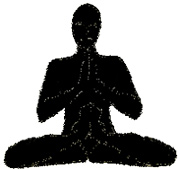
Steps
- Sit on the floor with the legs stretched straight in front. Bend the knees, widen the thighs, bring the feet towards the trunk until the heels are close to the perineum and keep the knees on the floor. The position is similar to Baddhakonasana.
- Hold the right foot with the right palm and the left foot with the left palm.
- With the help of the hands, draw the feet up towards the trunk, invert the ankle, pull the knees and thighs, and place the heels and the outer sides of the feet against the navel and chest. To start with the feet are likely to slip down. Practice the pose for a few weeks, holding the feet firmly against the chest.
- Release the hands, and either stretch the arms straight and rest the back of the hands on the knees or join the palms in front of the chest. Keep the back erect and stay I n the pose for about 30 seconds with deep breathing.
- Advanced pupils may raise the hands, palms together, above the head. Then try to join the palms behind the back and balance.
- Hold the feet with the hands, lower them to the floor and rest.
- As the pelvic and other joints of the legs are rotated it takes a long time to master the pose.
GOMUKHASANA
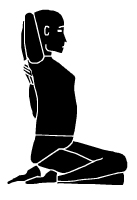
Steps
- Inhaling slowly through the nostrils bring right hand to the back. Bend it at the right elbow and then raise the back of the palm up towards the neck. In this process the back of the palm is pressed against the spine. The fingers of the right hand face upwards.
- Now raise left hand upwards bending at the elbow and put the left palm on the left shoulder. Then, first try to touch the fingers of the left hand with the right hand. If there is any difficulty in touching the fingers to some individuals, they should try as much as possible and then stay there.
- Try to raise the elbow of the left hand straight upwards (with the lock). Breathe normally. This is a Gomukhasana.
- Retain this locked position for about 30 sec. You can either hold the posture while the breath is held or you can try holding the posture while breathing gently through the nostrils. If you choose to breath, then hold the posture for thirty seconds to a minute.
- While releasing the posture, loosen the grip on the fingers and then unlock the fingers gradually. Then slowly bring both the hands on the thighs and rest.
VAJRASANA
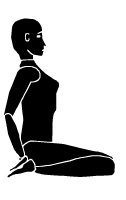
Steps
- With knees, ankles and big toes touching the ground, take a kneeling position.
- One should sit on the heels and place palms on the knees.
- The Spine should be erect and breath should be deep.
- Draw the abdominal region inside and expand the chest.
MANDUKASANA

Steps
- Take the posture of Vajrasana, fold your palms into fists and place them next to your navel.
- While Exhaling, gradually bend forward without raising your hips and rest the abdomen and fists over the thighs.
- Retain the posture for some time and while inhaling, return to normal position and relax.
SUPTAVAJRASANA

Steps
- Sit in Vajrasana.
- Lean back slowly from the waist with the support of your elbows till your head, shoulders and back touch the ground in easy stages without raising your knees from the floor or changing the position of the legs.
- Allow your back to come close to the ground and lie supine.
- Cross the arms and place the palms beneath the opposite shoulders so that the crossed wrists serve as a cushion for the head.
- Keep the knees together and touching the ground.
- Close your eyes.
- Catch hold of the ankles and return slowly to the starting position in the reverse order with the help of the elbows.
PADMASANA
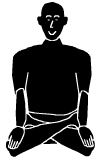
Steps
- For padmasana sit in the Dandasana (staff pose) with spine straight and legs extended in front of you.
- Then fold the right knee, put the right ankle on to the left thigh, and then pulls the left ankle over the folded right leg and places it on the right thigh.
- Take hold of both feet and ease them further in toward your groin, aiming for a balanced, symmetrical position.
- The head, neck and spine must be straight in Padmasana. Place the hands on the knees with the fingers depicting the holy sign, as in Chin or Jnana Mudra.
- Close the eyes and concentrate on your normal breathing. Sit in this posture as long as you can.
SIDDHASANA
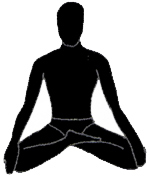
Steps
- Sit on the floor.
- Keep your legs stretch straight in front.
- Bend your left leg while holding the left heel.
- Place it near the perineum.
- Place the back of the hands on the knees so that the palms face upward.
- Join the thumb and tip of index finger of each of the hand.
- While doing the whole activity keep your spine erect.
- Put your neck low so that the chin touches the lower part of throat.
Diseases Related to Scorpio |
||


